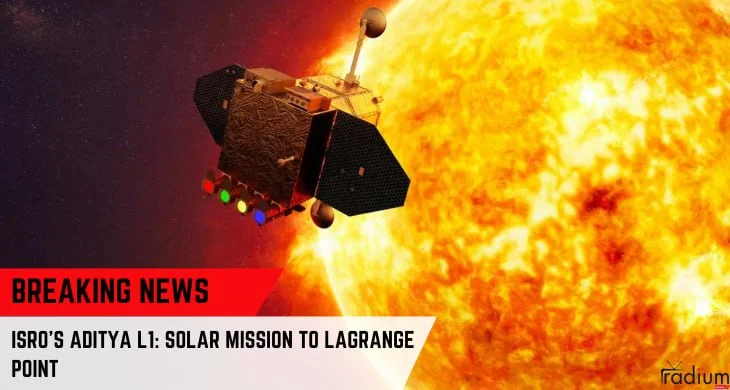ISRO’s first solar mission, Aditya L1,On 2 September 2023, the Aditya L1 will be launched by PSLV-C57 rocket from Sriharikota. This comes after Chandrayaan-3’s successful Moon landing last week.
ISRO’s goal for the Aditya L1 mission is to place the spacecraft in a “halo orbit” around Lagrange point 1 (L1) in the Sun-Earth system, situated around 1.5 million km from Earth.
The mission aims to analyze the effects of solar activities on space weather in real-time. ISRO’s objectives encompass studying phenomena like coronal heating, coronal mass ejections, pre-flare and flare activities, as well as understanding space weather dynamics, particle and field propagation, and more.
ISRO stated that the voyage to the designated mission site spans a remarkable distance of 1.5 million km from Earth and is expected to require approximately four months to complete.
Four-Month Journey of Aditya L1
According to ISRO’s explanation on its official website, the spacecraft will initially be positioned in a low Earth orbit. Subsequently, its orbit will be gradually elongated, and it will be propelled towards Lagrange point L1 using onboard propulsion. While en route to L1, Aditya L1 will exit Earth’s gravitational Sphere of Influence, marking the start of its “cruise phase.” Once beyond this influence, the spacecraft will enter a significant halo orbit encircling L1. ISRO added that the entire journey from launch to L1 is expected to take around four months for Aditya L1.
Lagrange Points, also known as libration points, are specific positions in space where the gravitational forces of two celestial bodies, like the Sun and Earth, create equilibrium zones. These points allow spacecraft to stay stable without constant fuel usage.
In setups like the Earth-Sun system, there are five Lagrange points denoted as L1 through L5. Among them, L1 and L2, situated closest to Earth, provide advantageous positions for carrying out observational studies.
What are the goals of the Aditya L1 mission?
The primary aims of ISRO’s inaugural solar mission encompass studying the dynamics of the solar upper atmosphere (chromosphere and corona); investigating phenomena like chromospheric and coronal heating, partially ionized plasma physics, coronal mass ejections, and solar flares; collecting in-situ data on particle and plasma environment to understand Sun-driven particle dynamics; and delving into the physics of solar corona and its heating mechanism.
Furthermore, the mission has the objective of examining the plasma diagnostics of coronal loops and the corona itself, encompassing parameters like temperature, velocity, and density. It seeks to analyze the development, dynamics, and origins of Coronal Mass Ejections (CMEs), understand the sequence of processes across various layers (chromosphere, base, and extended corona) that lead to solar eruptive events, investigate magnetic field topology and measurements in the solar corona, and explore the drivers of space weather, including the origin, composition, and dynamics of solar wind.
Frequently Asked Questions (FAQs)
Ques: What is ISRO’s Aditya L1 mission?
Ans: ISRO’s Aditya L1 is a solar mission aimed at studying the Sun’s dynamics, coronal heating, and space weather phenomena from Lagrange point 1 (L1) in the Sun-Earth system.
Ques: What is Lagrange point 1 (L1)?
Ans: Lagrange point 1 (L1) is a location in space where the gravitational forces of the Sun and Earth create a stable balance, allowing a spacecraft to maintain a relatively fixed position.
Ques: What objectives does the Aditya L1 mission aim to achieve?
Ans: The Aditya L1 mission aims to study solar upper atmospheric dynamics, coronal heating, plasma physics, initiation of coronal mass ejections (CMEs), flares, in-situ particle and plasma environment, solar corona and its heating mechanism, and more.
Ques: What is the significance of studying space weather?
Ans: Understanding space weather is crucial as it affects satellite operations, communication systems, power grids, and even human space travel. Aditya L1’s observations contribute to better space weather predictions.
Ques: How will Aditya L1 reach Lagrange point 1 (L1)?
Ans: Aditya L1 will be initially placed in a low Earth orbit and then transitioned into an elliptical orbit. Using onboard propulsion, it will gradually move towards L1, reaching a halo orbit around the point.
Conclusion:
This mission reflects ISRO’s commitment to advancing space exploration and scientific research, contributing to our knowledge of the universe and enhancing our capabilities in space technology. As Aditya L1 embarks on its journey, it symbolizes our ongoing endeavor to unravel the secrets of the cosmos and unlock the potential for a more informed and prepared future.
Stay informed with the latest updates and breaking news, brought to you by radiumnews.

